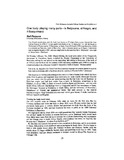| dc.contributor.author | Parsons, N. | |
| dc.date.accessioned | 2010-06-10T10:24:27Z | |
| dc.date.available | 2010-06-10T10:24:27Z | |
| dc.date.issued | 2002 | |
| dc.identifier.citation | Parsons, N. (2002) One body playing many parts-Ie Betjouana, el Negro, and il Bosquimano, Pula: Botswana Journal of African Studies Vol.16, No.1, pp. 19-29 | en_US |
| dc.identifier.issn | 0256-2316 | |
| dc.identifier.uri | http://hdl.handle.net/10311/507 | |
| dc.description.abstract | This article talks about how the body of El Negro was stolen from southern Africa and how it was kept as an exhibit in a museum in Spain. Two French taxidermists stole the body later known as El Negro from a grave beyond the Cape
Colony frontier in 1830-31. It was stuffed and displayed as 'Le Betjouana' (i.e. the Bechuana or
Motswana) in France and as '1/ Betjouana' in Spain. From 1916 until 1998 it was the prime exhibit
in a museum at Banyoles, north of Barcelona, where it became known as El Negro. Controversy
over its display began in 1991, and was complicated by the assertion that a 'Betjouana' was a type
of 'Bosquimano' (Bushman). | en_US |
| dc.language.iso | en | en_US |
| dc.publisher | University of Botswana, Research and Development Unit/http://digital.lib.msu.edu/projects/africanjournals/browse.cfm?colid=12 | en_US |
| dc.subject | One body | en_US |
| dc.subject | Parts | en_US |
| dc.subject | Betjouana | en_US |
| dc.subject | el Negro | en_US |
| dc.subject | Bosquimano | en_US |
| dc.title | One body playing many parts-Ie Betjouana, el Negro, and il Bosquimano | en_US |
| dc.type | Published Article | en_US |

